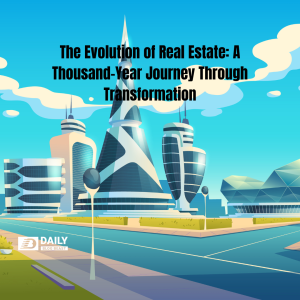Introduction:
The history of real estate spans centuries, reflecting the dynamic interplay of economic, social, and technological forces. From humble beginnings rooted in agricultural societies to the sprawling urban landscapes of today, the transformation of real estate has been nothing short of remarkable. This thousand-year journey unfolds a narrative of adaptation, innovation, and the continuous evolution of an industry that contributes significantly to our built environment.
I. Ancient Foundations:
The roots of real estate can be traced back to ancient civilizations, where landownership was intertwined with power and societal structure. Early on, in ancient Rome, the concept of private property and real estate transactions emerged, laying the groundwork for the legal frameworks that govern property ownership today. Land was not merely a commodity; it was a symbol of wealth, status, and permanence.
II. Feudalism and Agrarian Societies:
The feudal system that dominated medieval Europe significantly influenced the real estate landscape. Land was the primary source of wealth, and property ownership was concentrated among the aristocracy. Throughout history, serfs have worked the land in exchange for protection, giving rise to the manorial system. The ensuing centuries saw the gradual erosion of feudalism, with the emergence of land markets and a more diverse distribution of property ownership.
III. The Rise of Cities and Mercantile Economies:
The Renaissance marked a period of urbanization and economic diversification. Cities became centers of commerce and culture, leading to increased demand for urban real estate. The advent of property deeds and more sophisticated legal instruments facilitated property transactions, fostering the growth of a nascent real estate market.
IV. Industrial Revolution and Urbanization:
The 18th and 19th centuries witnessed the transformative impact of the Industrial Revolution. As industries flourished, urbanization surged, and a burgeoning middle class emerged. The need for housing and commercial spaces skyrocketed, prompting the development of urban planning and zoning regulations. Railroads and other transportation advancements further shaped real estate patterns, linking distant areas and expanding the reach of cities.
V. Twentieth Century: Suburbanization and Mass Homeownership:
The 20th century saw a paradigm shift in real estate with the rise of suburbanization. Improved transportation, the automobile revolution, and changing lifestyles led to the expansion of suburbs. The American dream of homeownership became a widespread aspiration, fueled by government-backed initiatives such as the Federal Housing Administration (FHA) and the GI Bill. Mass production techniques applied to housing construction further democratized access to homeownership.
VI. Globalization and Technological Revolution:
The latter half of the 20th century witnessed unprecedented globalization and the advent of the information age. Real estate, once bound by local and national borders, became a global asset class. The internet revolutionized property listings and facilitated virtual transactions, connecting buyers and sellers across continents. Real estate investment trusts (REITs) emerged as a vehicle for diversified property investment, offering investors a variety of real estate assets to invest in.
VII. Sustainable Development and Environmental Considerations:
The 21st century brought a heightened awareness of environmental issues and sustainability. Real estate practices adapted to incorporate green building technologies, energy-efficient design, and a focus on eco-friendly urban planning. LEED certification and other sustainability standards became benchmarks for responsible real estate development, reflecting a growing societal emphasis on environmental responsibility.
VIII. Proptech Revolution:
The integration of technology into real estate, often referred to as Proptech, has been a game-changer in recent years. From blockchain-based property transactions to artificial intelligence-powered property management, technology is reshaping every facet of the real estate lifecycle. Virtual reality (VR) and augmented reality (AR) are transforming property viewing experiences, allowing potential buyers to explore homes remotely.
IX. Post-Pandemic Real Estate:
The COVID-19 pandemic, a global crisis of unprecedented proportions, has had a profound impact on real estate. Remote work became the norm for many, altering the dynamics of urban and suburban living. The demand for flexible spaces, such as coworking facilities and hybrid office models, rose. The pandemic underscored the importance of resilient and adaptable real estate strategies, influencing both residential and commercial markets.
Conclusion:
The transformation of real estate over the past thousand years reflects the ever-changing tapestry of human civilization. From the agricultural fields of ancient times to the high-tech landscapes of today, real estate has adapted to the needs and aspirations of each era. The journey continues, propelled by technological advancements, environmental imperatives, and the dynamic interplay of economic forces. As we navigate the challenges and opportunities of the future, the evolution of real estate remains an enduring testament to the resilience and innovation of the human spirit.


